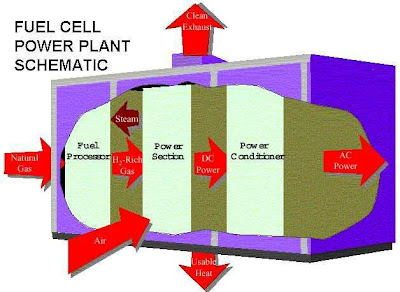
Using hydrogen to power a building is possible
You would have heard of hydrogen fuel cells powered cars or hybrid cars that give incredible efficiency. Hydrogen fuel is a mixture of petrol and fuel cells. Owners are extremely happy with its efficiency, and virtually negligible noise and smoke pollution.
Fuel cell technology is a reality in many countries with fuel cells generating electricity for homes, remote schools, IT infrastructure, and even military installations. These power plants generate power just like the regular power plants in several parts of the world. Governments are supporting research organisations to come up with alternate energy programmes and reduce dependency on oil and conventional fossil fuel. Iceland is converting all their fishing boats and trawlers to fuel cells. It is converting the existing diesel and replacing the conventional fossil fuel completely in the country.
This technology revolutionises power generation. As an alternate source of energy it is available in India. We, however, need to take responsibility for a greener environment. Depletion of oil resources have already driven governments of developed countries to invest in this technology and several of them have borne fruit. It has been commercialised to the maximum extent possible.
Fuel cells generate electricity from an electrochemical reaction in which oxygen (air) and fuel (hydrogen) combine to form water and the resultant heat. They are of many types but all are based on a central design. The electricity produced can power cars and buses to apartment blocks and large campuses.
Advanced fuel cells are stationary units with little or no moving parts producing heat and electricity. They are very efficient and have low emissions, thus favoured by the army. They are ideal for remote areas with unreliable electricity supply. There is huge potential for residential applications. These units could power houses or groups of houses for base loads or pre-determined loads. Natural gas can provide the source of hydrogen fuel. Other sources include solar, wind, and hydro power.
This technology has not gained grounds due to the fact that it was developed by people with significant scientific curiosity but no business skills. However, in the past years, this has changed with aggressive customerdriven companies trying to address this deficiency. In the automobile sector, due to higher legislation of emission standards like in California, manufacturers are to mandatorily supply a fixed percentage of zero emission vehicles. Toyota's Prius can travel between Sydney and Melbourne with less than just a tank-full of petrol whereas the rest is powered by its fuel cells. Similarly, Honda and Daimler Chrysler, among others, are also powering their cars with fuel cells.
Small and large fuel cells can produce heat and electricity. Homes and businesses can save on costs as their requirements from other sources decrease. Organisations dedicated to research and commercialisation can mainly be found in the US, Europe and Japan. Organisations in India, Korea and China are becoming a force to be reckoned with in the near future but many here are not aware of this technology. Fuel cell technology is a very vast subject. Proton Exchange Membrane (PEM) has gained a lot of ground. It helps in adaptation of fuel cells in mass transportation. Some of the US-based large manufacturers are specialising in stationary power generation units while others are manufacturing power plants. The same technology is being used in batteries and laptops. Fuel cells have double the efficiency when converting fuel to power as compared to the conventional internal combustion engine.
No comments:
Post a Comment